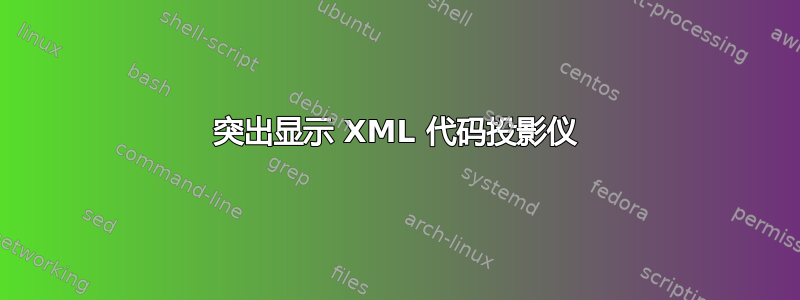
为了突出显示 XML 代码,我参考了XML 语法突出显示,所以我写:
\documentclass[10pt]{beamer}
\usepackage{listings}
\usepackage{color}
\definecolor{gray}{rgb}{0.4,0.4,0.4}
\definecolor{darkblue}{rgb}{0.0,0.0,0.6}
\definecolor{cyan}{rgb}{0.0,0.6,0.6}
\lstset{
basicstyle=\ttfamily,
columns=fullflexible,
showstringspaces=false,
commentstyle=\color{gray}\upshape
}
\lstdefinelanguage{XML}
{
morestring=[b]",
morestring=[s]{>}{<},
morecomment=[s]{<?}{?>},
stringstyle=\color{black},
identifierstyle=\color{darkblue},
keywordstyle=\color{cyan},
morekeywords={xmlns,version,type}% list your attributes here
}
\begin{document}
\begin{frame}[fragile]{Structure}
\lstset{language=XML}
\begin{lstlisting}
<?xml version="1.0" encoding="iso-8859-1"?>
<country>
<name> France </name>
<city> Paris </city>
<region>
<name> Nord-Pas De Calais </name>
<population> 3996 </population>
<city> Lille </city>
</region>
<region>
<name> Valle du Rhone </name>
<city> Lyon </city>
<city> Valence </city>
</region>
</country>
\end{lstlisting}
\end{frame}
\end{document}
现在我想把一些标签放在证据中,给它们上色或者放在彩色矩形中,我找了这两个帖子标记伪代码块并在其附近插入注释或者Beamer - 源代码突出显示/注释提示但我不明白它是如何工作的。
答案1
为了回答这个问题,我从标记伪代码块并在其附近插入注释。我认为甚至可以采用丹尼尔的方法,如下所示Beamer - 源代码突出显示/注释提示(也许将来我也会用这种方式来完成答案)。
这种方法的关键点是在环境中使用转义字符lstlisting。这可以通过以下方式实现:
\lstset{
escapechar=* % <= to escape to LaTeX
}
完整代码如下:
\documentclass[10pt]{beamer}
\usepackage{lmodern}
\usepackage{listings}
\usepackage{tikz}
\usetikzlibrary{calc}
% to change colors
\newcommand{\fillcol}{orange!20}
\newcommand{\bordercol}{black}
\makeatletter
% code from Andrew Stacey (with small adjustment to the border color)
% https://tex.stackexchange.com/questions/51582/background-coloring-with-overlay-specification-in-algorithm2e-beamer-package
\newcounter{jumping}
\resetcounteronoverlays{jumping}
\def\jump@setbb#1#2#3{%
\@ifundefined{jump@#1@maxbb}{%
\expandafter\gdef\csname jump@#1@maxbb\endcsname{#3}%
}{%
\csname jump@#1@maxbb\endcsname
\pgf@xa=\pgf@x
\pgf@ya=\pgf@y
#3
\pgfmathsetlength\pgf@x{max(\pgf@x,\pgf@xa)}%
\pgfmathsetlength\pgf@y{max(\pgf@y,\pgf@ya)}%
\expandafter\xdef\csname jump@#1@maxbb\endcsname{\noexpand\pgfpoint{\the\pgf@x}{\the\pgf@y}}%
}
\@ifundefined{jump@#1@minbb}{%
\expandafter\gdef\csname jump@#1@minbb\endcsname{#2}%
}{%
\csname jump@#1@minbb\endcsname
\pgf@xa=\pgf@x
\pgf@ya=\pgf@y
#2
\pgfmathsetlength\pgf@x{min(\pgf@x,\pgf@xa)}%
\pgfmathsetlength\pgf@y{min(\pgf@y,\pgf@ya)}%
\expandafter\xdef\csname jump@#1@minbb\endcsname{\noexpand\pgfpoint{\the\pgf@x}{\the\pgf@y}}%
}
}
\tikzset{%
remember picture with id/.style={%
remember picture,
overlay,
draw=\bordercol,
save picture id=#1,
},
save picture id/.code={%
\edef\pgf@temp{#1}%
\immediate\write\pgfutil@auxout{%
\noexpand\savepointas{\pgf@temp}{\pgfpictureid}}%
},
if picture id/.code args={#1#2#3}{%
\@ifundefined{save@pt@#1}{%
\pgfkeysalso{#3}%
}{
\pgfkeysalso{#2}%
}
},
onslide/.code args={<#1>#2}{%
\only<#1>{\pgfkeysalso{#2}}%
},
alt/.code args={<#1>#2#3}{%
\alt<#1>{\pgfkeysalso{#2}}{\pgfkeysalso{#3}}%
},
stop jumping/.style={
execute at end picture={%
\stepcounter{jumping}%
\immediate\write\pgfutil@auxout{%
\noexpand\jump@setbb{\the\value{jumping}}{\noexpand\pgfpoint{\the\pgf@picminx}{\the\pgf@picminy}}{\noexpand\pgfpoint{\the\pgf@picmaxx}{\the\pgf@picmaxy}}
},
\csname jump@\the\value{jumping}@maxbb\endcsname
\path (\the\pgf@x,\the\pgf@y);
\csname jump@\the\value{jumping}@minbb\endcsname
\path (\the\pgf@x,\the\pgf@y);
},
}
}
\def\savepointas#1#2{%
\expandafter\gdef\csname save@pt@#1\endcsname{#2}%
}
\def\tmk@labeldef#1,#2\@nil{%
\def\tmk@label{#1}%
\def\tmk@def{#2}%
}
\tikzdeclarecoordinatesystem{pic}{%
\pgfutil@in@,{#1}%
\ifpgfutil@in@%
\tmk@labeldef#1\@nil
\else
\tmk@labeldef#1,(0pt,0pt)\@nil
\fi
\@ifundefined{save@pt@\tmk@label}{%
\tikz@scan@one@point\pgfutil@firstofone\tmk@def
}{%
\pgfsys@getposition{\csname save@pt@\tmk@label\endcsname}\save@orig@pic%
\pgfsys@getposition{\pgfpictureid}\save@this@pic%
\pgf@process{\pgfpointorigin\save@this@pic}%
\pgf@xa=\pgf@x
\pgf@ya=\pgf@y
\pgf@process{\pgfpointorigin\save@orig@pic}%
\advance\pgf@x by -\pgf@xa
\advance\pgf@y by -\pgf@ya
}%
}
\newcommand\tikzmark[2][]{%
\tikz[remember picture with id=#2] #1;}
\makeatother
\newcommand<>{\boxto}[1]{%
\only#2{\tikz[remember picture with id=#1]
\draw[line width=0.75pt,fill=\fillcol,rectangle,rounded corners]
(pic cs:#1) ++(0.2,-.09) rectangle (0.03,0.29)
;\tikz\node [anchor=base] (#1){};}% <= insertion to store the anchor to be used as based for the annotation
}
\usepackage{color}
\definecolor{gray}{rgb}{0.4,0.4,0.4}
\definecolor{darkblue}{rgb}{0.0,0.0,0.6}
\definecolor{cyan}{rgb}{0.0,0.6,0.6}
\lstset{
basicstyle=\ttfamily,
columns=fullflexible,
showstringspaces=false,
commentstyle=\color{gray}\upshape,
escapechar=* % <= to escape to LaTeX
}
\lstdefinelanguage{XML}
{
morestring=[b]",
morestring=[s]{>}{<},
morecomment=[s]{<?}{?>},
stringstyle=\color{black},
identifierstyle=\color{darkblue},
keywordstyle=\color{cyan},
morekeywords={xmlns,version,type}% list your attributes here
}
\begin{document}
\begin{frame}[fragile]{Structure}
\lstset{language=XML}
\begin{lstlisting}
<?xml version="1.0" encoding="iso-8859-1"?>
*\boxto<1->{a}*<country>*\tikzmark{a}*
<name> France </name>
<city> Paris </city>
<region>
<name> Nord-Pas De Calais </name>
<population> 3996 </population>
<city> Lille </city>
</region>
<region>
*\boxto<2->{b}*<name> Valle du Rhone </name>*\tikzmark{b}*
<city> Lyon </city>
*\boxto<2->{c}*<city> Valence </city>*\tikzmark{c}*
</region>
</country>
\end{lstlisting}
\end{frame}
\end{document}
这使:




